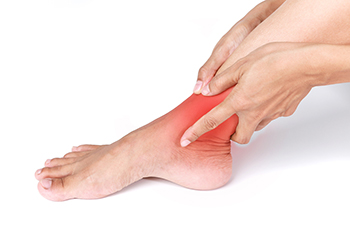Connect With Us
Blog
Items filtered by date: March 2025
Arthritis Can Cause Pain in the Feet and Ankles
Facts About Foot Stress Fractures

A foot stress fracture is a small crack in a bone caused by repetitive force or overuse. It often feels like a dull ache that worsens with activity and improves with rest. Over time, the pain may become more intense, accompanied by swelling and tenderness at the fracture site. Common causes include sudden increases in physical activity, improper footwear, and weakened bones due to conditions like osteoporosis. Athletes and others who engage in high-impact activities are at higher risk of developing foot stress fractures. Healing time varies but typically takes several weeks, depending on age, nutrition, and activity level. Rest, proper footwear, and a gradual return to activity are essential for recovery. If you have sustained a foot stress fracture, it is suggested that you promptly consult a podiatrist who can effectively diagnose and treat this foot condition.
Stress fractures occur when there is a tiny crack within a bone. To learn more, contact Stephanie Oexeman, DPM from Oexeman Foot and Ankle, PLLC. our doctor can provide the care you need to keep you pain free and on your feet.
How Are They Caused?
Stress fractures are the result of repetitive force being placed on the bone. Since the lower leg and feet often carry most of the body’s weight, stress fractures are likely to occur in these areas. If you rush into a new exercise, you are more likely to develop a stress fracture since you are starting too much, too soon. Pain resulting from stress fractures may go unnoticed at first, however it may start to worsen over time.
Risk Factors
- Gender – They are more commonly found in women compared to men.
- Foot Problems – People with unusual arches in their feet are more likely to develop stress fractures.
- Certain Sports – Dancers, gymnasts, tennis players, runners, and basketball players are more likely to develop stress fractures.
- Lack of Nutrients – A lack of vitamin D and calcium may weaken the bones and make you more prone to stress fractures
- Weak Bones – Osteoporosis can weaken the bones therefore resulting in stress fractures
Stress fractures do not always heal properly, so it is important that you seek help from a podiatrist if you suspect you may have one. Ignoring your stress fracture may cause it to worsen, and you may develop chronic pain as well as additional fractures.
If you have any questions please contact our office located in Chicago, IL . We offer the newest diagnostic and treatment technologies for all your foot and ankle needs.
Ankle Problems That Require Surgery

Ankle problems that require surgery often result from injuries, instability, or degenerative conditions that do not improve with other treatments. A podiatrist may recommend surgery for severe ankle fractures to realign bones and stabilize the joint using metal plates or screws. Chronic ankle instability, often the result of chronic sprains, may require lateral ankle ligament reconstruction to restore strength and function. When arthritis leads to significant pain and stiffness, ankle fusion may be performed to permanently join bones, which reduces discomfort but limits motion. In cases of advanced joint deterioration, ankle replacement may be needed. In this case, damaged bone and cartilage are replaced with prosthetic components to restore mobility. A ruptured Achilles tendon, often caused by trauma, may require surgery to stitch the torn ends together and ensure proper healing. Recovery times from ankle surgery vary depending on the extent of the injury and type of procedure. If you have a serious ankle problem, it is suggested that you make an immediate appointment with a podiatrist for an exam, diagnosis, and treatment.
Foot surgery is sometimes necessary to treat a foot ailment. To learn more, contact Stephanie Oexeman, DPM of Oexeman Foot and Ankle, PLLC. our doctor will assist you with all of your foot and ankle needs.
When Is Surgery Necessary?
Foot and ankle surgery is generally reserved for cases in which less invasive, conservative procedures have failed to alleviate the problem. Some of the cases in which surgery may be necessary include:
- Removing foot deformities like bunions and bone spurs
- Severe arthritis that has caused bone issues
- Cosmetic reconstruction
What Types of Surgery Are There?
The type of surgery you receive will depend on the nature of the problem you have. Some of the possible surgeries include:
- Bunionectomy for painful bunions
- Surgical fusion for realignment of bones
- Neuropathy decompression surgery to treat nerve damage
Benefits of Surgery
Although surgery is usually a last resort, it can provide more complete pain relief compared to non-surgical methods and may allow you to finally resume full activity.
Surgical techniques have also become increasingly sophisticated. Techniques like endoscopic surgery allow for smaller incisions and faster recovery times.
If you have any questions, please feel free to contact our office located in Chicago, IL . We offer the newest diagnostic and treatment technologies for all your foot care needs.
Why Your Achilles Tendon Might Be Holding You Back

Achilles tendinopathy is not just a runner’s problem. It can strike anyone who overworks their Achilles tendon without enough recovery. This overuse injury happens when tiny, repeated strains cause the tendon to weaken and thicken, making every step feel stiff and sore. The pain usually starts as a dull ache in the back of the heel or lower calf, especially after activity. Ignoring it can lead to worsening pain and even a rupture. Rest and targeted exercises are key. Stretching, strengthening exercises, and supportive footwear can help the tendon heal. A podiatrist may also recommend orthotics or shockwave therapy for stubborn cases. If your Achilles tendon has been nagging you for weeks, it is suggested that you see a podiatrist for treatment.
Achilles tendon injuries need immediate attention to avoid future complications. If you have any concerns, contact Stephanie Oexeman, DPM of Oexeman Foot and Ankle, PLLC. our doctor can provide the care you need to keep you pain-free and on your feet.
What Is the Achilles Tendon?
The Achilles tendon is a tendon that connects the lower leg muscles and calf to the heel of the foot. It is the strongest tendon in the human body and is essential for making movement possible. Because this tendon is such an integral part of the body, any injuries to it can create immense difficulties and should immediately be presented to a doctor.
What Are the Symptoms of an Achilles Tendon Injury?
There are various types of injuries that can affect the Achilles tendon. The two most common injuries are Achilles tendinitis and ruptures of the tendon.
Achilles Tendinitis Symptoms
- Inflammation
- Dull to severe pain
- Increased blood flow to the tendon
- Thickening of the tendon
Rupture Symptoms
- Extreme pain and swelling in the foot
- Total immobility
Treatment and Prevention
Achilles tendon injuries are diagnosed by a thorough physical evaluation, which can include an MRI. Treatment involves rest, physical therapy, and in some cases, surgery. However, various preventative measures can be taken to avoid these injuries, such as:
- Thorough stretching of the tendon before and after exercise
- Strengthening exercises like calf raises, squats, leg curls, leg extensions, leg raises, lunges, and leg presses
If you have any questions please feel free to contact our office located in Chicago, IL . We offer the newest diagnostic tools and technology to treat your foot and ankle needs.
Managing Ankle Pain

Ankle injuries, such as sprains, strains, and tendonitis, can cause significant discomfort and impact daily activities. A sprain occurs when ligaments are stretched or torn, while a strain affects muscles or tendons. Tendonitis involves inflammation of the tendons, often due to overuse. Symptoms include swelling, bruising, pain, stiffness, and difficulty walking or moving the ankle. A podiatrist can help diagnose the specific injury through a physical exam or imaging. Depending on the severity, treatment may include targeted exercises for strength and flexibility, medication, custom orthotics, or even surgery. If you are experiencing pain, swelling, or limited mobility due to an ankle injury, it is important to seek professional care. A podiatrist can help alleviate your ankle pain, improve function, and guide recovery. If you have ankle pain, it is suggested that you schedule an appointment with a podiatrist.
Ankle pain can have many different causes and the pain may potentially be serious. If you have ankle pain, consult with Stephanie Oexeman, DPM from Oexeman Foot and Ankle, PLLC. our doctor will assess your condition and provide you with quality foot and ankle treatment.
Ankle pain is any condition that causes pain in the ankle. Due to the fact that the ankle consists of tendons, muscles, bones, and ligaments, ankle pain can come from a number of different conditions.
Causes
The most common causes of ankle pain include:
- Types of arthritis (rheumatoid, osteoarthritis, and gout)
- Ankle sprains
- Broken ankles
- Achilles tendinitis
- Achilles tendon rupture
- Stress fractures
- Tarsal tunnel syndrome
- Plantar fasciitis
Symptoms
Symptoms of ankle injury vary based upon the condition. Pain may include general pain and discomfort, swelling, aching, redness, bruising, burning or stabbing sensations, and/or loss of sensation.
Diagnosis
Due to the wide variety of potential causes of ankle pain, podiatrists will utilize a number of different methods to properly diagnose ankle pain. This can include asking for personal and family medical histories and of any recent injuries. Further diagnosis may include sensation tests, a physical examination, and potentially x-rays or other imaging tests.
Treatment
Just as the range of causes varies widely, so do treatments. Some more common treatments are rest, ice packs, keeping pressure off the foot, orthotics and braces, medication for inflammation and pain, and surgery.
If you have any questions please feel free to contact our office located in Chicago, IL . We offer the newest diagnostic tools and technology to treat your foot and ankle needs.


